Development and Characterization of Darbepoetin Alfa
Studies on human erythropoietin (EPO) demonstrated that there is a direct relationship between the sialic acid-containing carbohydrate content of the molecule and its serum half-life and in vivo biological activity, but an
ABSTRACT:Studies on human erythropoietin (EPO) demonstrated that there is a direct relationship between the sialic acid-containing carbohydrate content of the molecule and its serum half-life and in vivo biological activity, but an inverse relationship with its receptor-binding affinity. These observations led to the hypothesis that increasing the carbohydrate content, beyond that found naturally, would lead to a molecule with enhanced biological activity. Hyperglycosylated recombinant human EPO (rHuEPO) analogs were developed to test this hypothesis. Darbepoetin alfa (Aranesp), which was engineered to contain five N-linked carbohydrate chains (two more than rHuEPO), has been evaluated in preclinical animal studies. Due to its increased sialic acid-containing carbohydrate content, darbepoetin alfa is biochemically distinct from rHuEPO, having an increased molecular weight and greater negative charge. Compared with rHuEPO, it has an approximate threefold longer serum half-life, greater in vivo potency, and can be administered less frequently to obtain the same biological response. Darbepoetin alfa is currently being evaluated in human clinical trials for treatment of anemia and reduction in its incidence. [ONCOLOGY 16(Suppl 11):13-22, 2002]
Erythropoietin (EPO) is a glycoprotein hormone that is the primary regulator of erythropoiesis, maintaining the body’s red blood cell mass at an optimum level.[1,2] In response to a decrease in tissue oxygenation, EPO synthesis increases in the kidney. The secreted hormone binds to specific receptors on the surface of red blood cell precursors in the bone marrow, leading to their survival, proliferation and differentiation, and ultimately to an increase in hematocrit.[3,4]
Since its introduction more than a decade ago, recombinant human EPO (rHuEPO) has become the standard of care in treating the anemia associated with chronic renal failure (CRF). It is highly effective at correcting the anemia, restoring energy levels, and increasing patient well-being and quality of life.[5-8] It has also been approved for the treatment of anemia associated with cancer, HIV infection, and use in the surgical setting to decrease the need for allogeneic blood transfusions. For all indications, it has proven to be remarkably well tolerated and highly efficacious.[9-11]
The recommended and usual therapy with rHuEPO is two to three times per week by subcutaneous or intravenous injection. For CRF patients, the duration of therapy is for the life of the patient, or until a successful kidney transplant restores kidney function, including the production of the natural hormone. For cancer patients, rHuEPO therapy is indicated for as long as the anemia persists, generally through the entire course of chemotherapy.
It can be a hardship to administer rHuEPO two to three times per week, particularly for those patients who do not otherwise need to be seen in the clinic this frequently. In these cases, the patient needs to make a special trip to the clinic for his or her rHuEPO therapy. As is true for all growth factors, reduction in dose frequency results in a significant loss in efficiency. That is, the total weekly dose required when rHuEPO is administered one time per week is greater than when it is administered as two to three divided doses. It was anticipated that this clinical need could be addressed by creating a molecule with enhanced in vivo bioactivity to allow for less frequent dosing of patients.
To create a molecule with enhanced activity, research was initially directed towards elucidating those factors and structural features that control the in vivo activity of EPO.[12] This research led to the discovery and development of darbepoetin alfa, a novel erythropoiesis stimulating protein (Aranesp), that can be administered less frequently than epoetin.[13]
Structure of EPO
Human EPO is a 30,400-dalton heavily glycosylated protein hormone.[14,15] Sixty percent (by weight) of the molecule is an invariant 165 amino acid single polypeptide chain containing two disulfide bonds.[16,17] The remaining 40% of the mass of the molecule is carbohydrate. Carbohydrate addition (glycosylation) is a posttranslational event that results in the addition of sugar chains to specific asparagine (N-linked) or serine/threonine (O-linked) amino acids in the polypeptide. The carbohydrate portion of natural and recombinant human EPO consists of three N-linked sugar chains at Asn 24, 38, and 83, and one O-linked (mucin-type) sugar chain at Ser 126.[18,19]
Structure determinations using nuclear magnetic resonance spectroscopy[20] and x-ray crystallography[21] have indicated that human EPO is an elongated molecule with an overall topology of a left-handed four-helix bundle, typical of members of the hematopoietic growth factor family. In addition, these studies have identified the amino acids at the receptor-binding sites. The carbohydrate addition sites are clustered at one end of the molecule, distal from the receptor-binding site. While the four carbohydrate chains contribute approximately 40% of the mass of the hormone, they probably cover much of the surface of the molecule since they have an extended and flexible molecular structure.
In contrast to the invariant amino acid sequence of the protein portion of glycoproteins, the carbohydrate structures are variable, a feature referred to as microheterogeneity. For example, N-glycosylation sites on the same protein may contain different carbohydrate structures. Furthermore, even at the same glycosylation site on a given glycoprotein, different structures may be found. This heterogeneity is a consequence of the non-template-directed synthesis of carbohydrates.
FIGURE 1
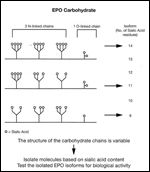
Schematic of EPO Carbohydrate Structure and EPO Isoform Designation. EPO = erythropoietin
The carbohydrate structures of EPO have been determined and the extent of the microheterogeneity defined for both rHuEPO and the natural hormone.[22-25] One of the most prominent examples of microheterogeneity for EPO is seen on the N-linked carbohydrate chains, where the oligosaccharides may contain two, three, or four branches (or antennae), each of which is typically terminated with the negatively-charged sugar molecule, sialic acid (Figure 1). With the exception of sialic acid, all of the other sugar molecules on EPO are neutral. Similarly, the single O-linked carbohydrate may contain zero to two sialic acid molecules. Since each of the three N-linked oligosaccharides can contain up to four sialic acid residues, and the single O-linked chain can contain two, the EPO molecule can have a maximum of 14 sialic acid residues.
Therefore, because of the variability in sugar structure, the number of sialic acid molecules on EPO varies, and as a consequence, so does the molecule’s net negative charge. As indicated in Figure 1, an isoform of EPO is defined as a subset of the EPO molecules that has a defined charge due to its sialic acid content. For reference, epoetin alfa (Epogen, Procrit), the source of the purified rHuEPO used for these studies, has been purified so as to contain isoforms 9 to 14.
Role of Carbohydrate in Biological Activity
The carbohydrate portions of different glycoprotein molecules have been shown to have many diverse functions, including effects on the biosynthesis and secretion, immune protection, conformation, stability, solubility, and biological activity of molecules.[26,27] For rHuEPO, in particular, it has been shown that the addition of carbohydrate is required for secretion from the cell, and for increasing the solubility of the molecule.[28-30] Early research on EPO from natural sources indicated that the sialic acid residues were necessary for biological activity in vivo.[31-33] Removal of the sialic acid from either native EPO or rHuEPO resulted in molecules having an increased activity in vitro, but very low activity in vivo, presumably due to removal from circulation by the asialoglycoprotein receptor in the liver.[34,35] Similarly, it was shown that EPO molecules, which have been deglycosylated to remove carbohydrate (or produced in Escherichia coli to allow expression of only the EPO polypeptide), are active in vitro, but have very low in vivo activity.[36,37]
In order to define further the role of carbohydrate in biological activity, the approach taken was to purify EPO carbohydrate isoforms, measure their in vivo activity and determine how the different carbohydrate structures affect activity.
FIGURE 2
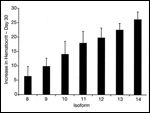
In Vivo Efficacy of Isolated EPO Isoforms
rHuEPO, produced by Chinese hamster ovary cells, was purified to contain the entire complement of isoforms 4 to 14, and then further fractionated by ion exchange chromatography to isolate the individual isoforms.[12] The in vivo efficacy of each of the individual isoforms was tested in normal mice to determine the effect of repetitive dosing on the hematocrit. In this assay, CD-1 mice were injected with either a vehicle control or an equimolar dose (2.5 µg/kg of peptide) of each of the individual isoforms by intraperitoneal injection three times per week for 1 month. The results of this experiment demonstrated a striking difference in the biological activity of the individual isoforms, with those isoforms having a higher sialic acid content exhibiting a progressively higher in vivo efficacy (Figure 2). By day 30, the group mean hematocrit of isoform 14-treated animals increased by 26.2 ± 2.7 points (to a hematocrit of 76.2%), compared with an increase of only 6.3 ± 3.5 points for the isoform 8-treated group, a 4.2-fold increase in efficacy. In contrast, animals receiving vehicle control showed no hematocrit change from baseline during the experiment.
It was reasoned that these results might have two possible explanations: the more active isoforms might have a longer serum half-life and/or an increased ability to bind to the EPO receptor. In order to assess the contribution of each of these possibilities, the pharmacokinetics and receptor-binding activity of the individual isoforms was measured.
FIGURE 3
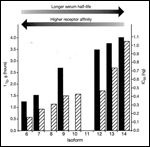
EPO Isoforms Having a Higher Sialic Acid Content Have a Longer Serum Half-Life and a Lower Receptor Binding Activity
The isolated EPO isoforms were iodinated and their circulating half-life determined after intravenous injection into rats. At specified intervals after dosing, blood samples were taken and the fraction of iodinated isoform remaining in circulation was measured. The isoforms with the increased sialic acid content had a longer serum half-life than those with the lower sialic acid content (Figure 3). The beta half-life of isoform 14 was 3.2-fold longer than that for isoform 6 (3.97 vs 1.24 hours, respectively). As expected from these results, the serum clearance of the isoforms progressively increased as the sialic acid content decreased. In contrast, the volume of distribution was the same for the individual isoforms and approximately equal to the plasma volume (data not shown). Thus, those isoforms that have a higher sialic acid content have a higher in vivo biological activity, longer serum half-life and slower serum clearance.
Next, the relative affinity of various EPO isoform preparations for the EPO receptor was determined in a radioreceptor assay.[38] This assay measures the quantity of each isoform required to displace 125I-rHuEPO bound to the EPO receptor on the surface of OCIM1 cells. The IC50, the amount of test compound required to compete 50% of the receptor-bound 125I-rHuEPO, was determined for each isoform. As seen in Figure 3, the higher the sialic acid content, the greater the quantity of EPO isoform necessary to compete 125I-rHuEPO binding. Thus, those isoforms having a higher sialic acid content had a lower relative affinity for the EPO receptor. The relative affinity of isoform 6 for the EPO receptor was sevenfold greater than that for isoform 14.
Taken together, these experiments indicate that the carbohydrate moieties of EPO have significant effects on the biological activity of the hormone, modulating both receptor affinity and serum clearance. There is a direct relationship between sialic acid content, in vivo biological activity, and serum half-life, but an inverse relationship with receptor affinity. While conventional wisdom might have predicted that increases in receptor affinity would lead to a more active molecule, clearly this is not the case. In fact, as shown in these experiments, isoform 9, which has a 2.6-fold greater affinity for the EPO receptor than isoform 14, has only approximately one-third of the in vivo activity (Figures 2 and 3). These observations clearly demonstrate that clearance has a far stronger influence on in vivo activity than does receptor-binding affinity. Increases in serum half-life were able to overcome the observed decreases in receptor affinity. Thus, for EPO, serum clearance, not receptor binding affinity, is the primary determinant of in vivo activity.
Design of Hyperglycosylated rHuEPO Analogs
In addition to identifying serum half-life as a major controlling factor of the in vivo biological activity of EPO, these experiments led to the hypothesis that increasing the sialic acid containing carbohydrate of EPO would increase its serum half-life and thereby the in vivo biological activity of the molecule.
To test this hypothesis, additional N-linked carbohydrate chains were added to the rHuEPO molecule. N-linked carbohydrate is attached to the polypeptide backbone at a consensus sequence for carbohydrate addition (Asn-XXX-Ser/Thr). To introduce new carbohydrate attachment sites into the polypeptide backbone, the DNA sequence of the cloned human EPO gene needed to be modified to code for one or more new consensus sequences. The consensus sequences needed to be added at positions that were compatible with carbohydrate addition. While the consensus sequence is necessary for carbohydrate addition, it is not sufficient to ensure that a carbohydrate addition site will be utilized. Other factors, such as the local protein folding and conformation during biosynthesis, determine whether an oligosaccharide is attached at a given consensus sequence site. In addition, the consensus sequences needed to be added to positions that did not interfere with receptor binding, or compromise the folding, conformation, or stability of the molecule.
At the time that these studies were initiated, there was only an incomplete understanding of the three-dimensional structure of EPO. This understanding was largely gained through site-directed mutagenesis studies where individual amino acids were changed and the result of the change evaluated for effects on bioactivity and conformation.[39,40] These structure/function experiments identified many of the amino acids that were critical for EPO receptor interaction and necessary for proper folding of the molecule. Although these studies provided insight as to which amino acids should not be altered, they did not allow identification of positions where extra carbohydrate addition sites could be added whilst maintaining structure.
To test this hypothesis, several dozen analogs of rHuEPO containing one or more amino acid substitutions, which created one or more new carbohydrate addition sites, were produced.[41] Site-directed mutagenesis was first used to change the nucleic acid sequence encoding one or more amino acids of a human EPO cDNA clone. Next, the clone encoding each new candidate analog was transfected into mammalian cells and the expressed protein analyzed. Only a few of the several dozen analogs tested were fully glycosylated, had the proper tertiary structure, and retained biological activity. The EPO analogs that were properly glycosylated each had one extra N-linked carbohydrate chain (4-chain analog). By combining the carbohydrate addition sites of two successfully glycosylated 4-chain analogs into one molecule, the 5 N-linked chain analog, darbepoetin alfa, was created. The amino acid sequence of darbepoetin alfa differs from that of human EPO at five positions (Ala30Asn, His32Thr, Pro87Val, Trp88Asn, and Pro90Thr) allowing for additional oligosaccharide attachment at asparagine residues at positions 30 and 88.[41]
FIGURE 4

Biochemical and Biological Properties of rHuEPO and rHuEPO Analogs Containing 4 and 5 N-linked Carbohydrate Chains
Due to the additional carbohydrate, these 4 and 5 N-linked (darbepoetin alfa) chain analogs are each biochemically distinct from rHuEPO (Figure 4). They have an increased molecular weight, sialic acid content and negative charge. Each additional N-linked carbohydrate chain increases the molecular weight of the protein by approximately 3,300 daltons and adds up to four additional sialic acid residues. Thus, in comparison with rHuEPO, the two extra carbohydrate chains on darbepoetin alfa increase the molecular weight by 22% (to 37,100 daltons) and the maximum number of sialic acid residues from 14 to 22.
Biological Activity of Hyperglycosylated rHuEPO Analogs
These analogs, having four and five N-linked carbohydrate chains, were used to test the hypothesis that increasing the sialic acid-containing carbohydrate content of EPO would increase the serum half-life and thereby the in vivo bioactivity.
FIGURE 5
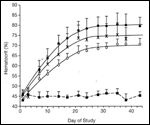
In Vivo Efficacy of rHuEPO (Isoforms 9 to 14), 4-Chain Analog, and Darbepoetin Alfa
The in vivo efficacy of rHuEPO, the 4-chain analog, and darbepoetin alfa (5-chain analog) were compared by measuring the increase in hematocrit of mice injected thrice-weekly with equimolar doses (2.5 µg/kg of peptide) of each molecule for 6 weeks (Figure 5). Both darbepoetin alfa and the 4-chain analog produced a faster rate of hematocrit rise and a higher stable plateau hematocrit than rHuEPO. By day 31 the hematocrit had increased by 22.8 ± 2.3, 28.1 ± 6.8, and 33.9 ± 3.4 points for mice treated with rHuEPO, 4-chain analog, and darbepoetin alfa, respectively and these hematocrit differences were maintained for the duration of the experiment. Consistent with the hypothesis, the magnitude of the hematocrit increase correlated with the number of carbohydrate chains and the sialic acid content of the molecules. Thus, by day 31, treatment with the 5-chain analog, darbepoetin alfa, increased the hematocrit 11 points more than rHuEPO, while the response produced by the 4-chain analog was intermediate between that of darbepoetin alfa and rHuEPO.
FIGURE 6
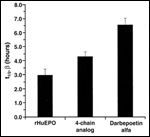
Serum Half-Life of rHuEPO (Isoforms 9 to 15), 4-Chain Analog, and Darbepoetin Alfa
To confirm that the mechanism of increased activity was due to an increase in the circulating half-life, the pharmacokinetics of rHuEPO, the 4-chain analog, and darbepoetin alfa were compared. As seen in Figure 6, the greater the sialic acid-containing carbohydrate content of the molecule, the longer its circulating half-life. The beta half-life of both hyperglycosylated molecules was greater than that determined for rHuEPO and for isoform 14, the highest of the naturally occurring EPO isoforms. In contrast, the volume of distribution was equivalent for the three molecules and approximately equal to the plasma volume (data not shown).
rHuEPO, the 4-chain analog, and darbepoetin alfa were tested for EPO receptor-binding activity in the radioreceptor assay. Consistent with the results obtained in this assay for the isolated isoforms and the hypothesis, the relative EPO receptor-binding affinity was inversely correlated with the carbohydrate content. The relative affinity of darbepoetin alfa for the EPO receptor was 4.3-fold lower than that of rHuEPO and significantly lower than that of isoform 14. The results with the 4-chain analog were intermediate between those of darbepoetin alfa and rHuEPO (data not shown).
These results confirm the hypothesis that the serum half-life of rHuEPO could be extended by increasing the sialic acid-containing carbohydrate content beyond that found naturally, and that the longer serum half-life would lead to an increase in in vivo biological activity (Figure 4). The results with the 4- and 5-chain hyperglycosylated EPO analogs were also consistent with the previous observations that the increases in serum half-life more than offset the decreases in receptor-binding affinity. The in vivo biological activity of both the 4-chain analog and darbepoetin alfa were greater than that of rHuEPO even though they each had a lower affinity for the EPO receptor.
Comparison of the in vivo Efficacy of Darbepoetin Alfa With rHuEPO
To further characterize darbepoetin alfa and evaluate its potential as a therapeutic for human use, comparative pharmacodynamic studies of darbepoetin alfa and rHuEPO were performed in normal mice using different frequencies and routes of administration over wide dose ranges. In particular, these studies focused on determining if the increase in serum half-life and in vivo activity would confer the clinical benefit of allowing for less frequent dosing.
FIGURE 7
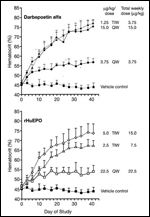
In Vivo Efficacy of Darbepoetin Alfa and rHuEPO Administered Three Times (TIW) or One Time (QW) per Week
As has been shown for rHuEPO, darbepoetin alfa produced a dose-dependent increase in the hematocrit of normal mice when injected by the intravenous, intraperitoneal, and subcutaneous routes.[13] Initial experiments focused on comparing the efficacy of the two molecules when administered three times per week. In the experiment shown in Figure 7, thrice-weekly intravenous dosing with 1.25 µg/kg of darbepoetin alfa increased the hematocrit of mice to approximately 75% in 6 weeks; however, a comparable hematocrit increase with rHuEPO at this dosing frequency required 5.0 µg/kg. When the data from all experiments were combined, darbepoetin alfa was determined to be approximately 3.6-fold more potent than rHuEPO when administered three times per week by any route of administration.
Darbepoetin alfa can successfully increase the hematocrit of mice when administered once per week (Figure 7). A once-weekly dose of 15 µg/kg darbepoetin alfa produced a nearly identical biological response in normal mice as did a thrice-weekly dose of 1.25 µg/kg (3.75 µg/kg total weekly dose). Thus, for darbepoetin alfa, an approximate fourfold weekly dose increase is required to change from thrice-weekly to once-weekly dosing in this animal model. It is important to note, however, that in human clinical studies, there were no apparent differences between once-weekly and thrice-weekly dosing with darbepoetin alfa.[42] The optimal weekly dose was the same whether administered once per week or as three divided doses. The differences observed between the small animal model, and human clinical trials are presumably due to the differences in the erythrokinetics and red blood cell lifespan of the two species.
Once-weekly dosing with rHuEPO is far less efficient than once-weekly dosing with darbepoetin alfa. As shown in Figure 7, once-weekly dosing with 22.5 µg/kg of rHuEPO increased the hematocrit by 7 points in 6 weeks, while a 2.5 µg/kg dose administered three times per week (7.5 µg/kg total weekly dose) increased the hematocrit by 22 points in the same time period. Integration of the data from all experiments demonstrated that for rHuEPO an approximate 15-fold weekly dose increase is required to change from thrice-weekly to once-weekly dosing in this animal model.
When the efficacy of once-weekly dosing of darbepoetin alfa and rHuEPO were compared, a striking difference in the potency of the two molecules was observed. As seen in Figure 7, a 3.75 µg/kg dose of darb-epoetin alfa administered one time per week increased the hematocrit by 12 points. In contrast, a sixfold higher dose of rHuEPO (22.5 µg/kg) increased the hematocrit by only 7 points. When relative potency plots were constructed from all of the data, darbepoetin alfa was found to be 13- to 14-fold more potent than rHuEPO when each was administered once-weekly.
FIGURE 8
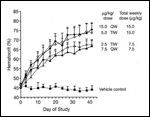
Comparative Efficacy of Darbepoetin Alfa Administered One Time per Week (QW) With rHuEPO Administered Three Times per Week (TIW)
As a consequence of the relative potency differences described above, darbepoetin alfa administered once-weekly is as effective as the same total weekly dose of rHuEPO given as three divided doses (Figure 8). These experiments demonstrate that the same dose of darbepoetin alfa can be administered less frequently than rHuEPO to obtain the same biological response. Furthermore, dosing with darbepoetin alfa as infrequently as once every other week can still increase the hematocrit of normal mice (data not shown).
As expected from the pharmacokinetic differences between darbepoetin alfa and rHuEPO, no one number can be used to express the relative potency difference between the two molecules. The relative potency of darbepoetin alfa and rHuEPO will necessarily change as a function of the dosing interval. Longer intervals between the administration of doses will lead to a greater potency difference. Thus, when each molecule is administered three times per week darbepoetin alfa is approximately 3.6-fold more potent than rHuEPO; however, when each molecule is administered once-weekly darbepoetin alfa is 13- to 14-fold more potent.
Comparative Pharmacokinetics of Darbepoetin Alfa and Epoetin Alfa in Dialysis Patients
FIGURE 9
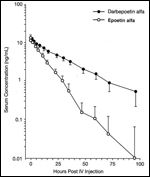
Comparative Pharmacokinetics of Darbepoetin Alfa and Epoetin Alfa in Anemic Dialysis Patients
The first step in the clinical program to determine if darbepoetin alfa is both more potent than epoetin alfa and can be administered less frequently, was to verify that darbepoetin alfa had a longer serum half-life in patients. In a double-blind, randomized crossover study, the single-dose pharmacokinetics of epoetin alfa (100 U/kg) and an equimolar dose of darb-epoetin alfa were compared after intravenous administration to 11 stable peritoneal dialysis patients.[43] Serum levels of darbepoetin alfa and rHuEPO were determined at regular intervals up to 96 hours after dosing by immunoassay. In all patients, darbepoetin alfa had a longer terminal half-life than epoetin alfa (Figure 9). The mean terminal half-life for darb-epoetin alfa following intravenous injection was 26.3 hours, approximately three-fold longer than that determined for epoetin alfa (8.5 hours). There was no significant difference in the volume of distribution for the two molecules. This first study in man confirmed and extended the observations in animal studies with darbepoetin alfa, demonstrating that due to its increased sialic acid-containing carbohydrate content, darbepoetin alfa has a decreased clearance and longer serum half-life than rHuEPO.
Ongoing clinical studies are evaluating the safety and relative efficacy of darbepoetin alfa as compared with epoetin alfa in different patient groups. Since the amino acid sequence of darbepoetin alfa differs at five amino acid positions from EPO, it is theoretically possible that darbepoetin alfa could be immunogenic. If darbepoetin alfa antibodies were to develop, they could be non-neutralizing (benign), or neutralizing, rendering darbepoetin alfa ineffective. In addition, either the neutralizing or non-neutralizing antibodies may cross-react with EPO. Due to this theoretical, but real, concern, patients are being closely monitored for the development of darbepoetin alfa antibodies in all clinical studies.
However, several important features of darbepoetin alfa suggest that the risk of immunogenicity may be minimal. One of the known functions of carbohydrate in glycoproteins is to act as a molecular shield, protecting the underlying polypeptide from the immune system.[26] Since the location of the five amino acid differences between darbepoetin alfa and EPO is at or proximal to the carbohydrate addition site, it is likely that these sites will be well shielded from immune surveillance. The fact that the new carbohydrate addition sites are distal to the receptor-binding site minimizes the possibility that any antibodies that develop would be neutralizing. Carbohydrate chains in themselves are rarely immunogenic and since all of the oligosaccharide structures on darbepoetin alfa are also found on epoetin, it is very unlikely that they will be immunogenic. Results from preclinical studies provide support for these considerations. In a mouse model, where the injection of heterologous human proteins is expected to lead to antibody formation, the incidence of seroconversion in darbepoe-tin alfa-treated animals was no higher than for rHuEPO-treated animals. Significantly, in all of the clinical trials to date, no patient has developed antibodies to darbepoetin alfa.
Conclusions
Darbepoetin alfa has been engineered to contain five N-linked carbohydrate chains (two more than rHuEPO). The additional carbohydrate affects the biochemical and biological properties of darbepoetin alfa (Figure 4). Due to the additional sialic acid-containing carbohydrate, darbepoetin alfa has a slower serum clearance and, therefore, a longer half-life than rHuEPO. The longer serum half-life increases the in vivo biological activity and allows darb-epoetin alfa to be administered less frequently than rHuEPO. The safety and efficacy of darbepoetin alfa for use as a therapeutic for the treatment of anemia and reduction in its incidence is being evaluated in ongoing clinical trials.
The development of darbepoetin alfa is an outgrowth of basic research directed towards elucidating those structural features that control the in vivo biological activity of EPO. It was discovered that the pharmacokinetic properties of rHuEPO have a stronger influence on in vivo activity than receptor affinity and that the serum clearance of rHuEPO could be manipulated by changing the proportion of sialic acid-containing carbohydrate. These observations may be applicable for optimization of other protein therapeutics for clinical use.
References:
1. Krantz SB: Erythropoietin. Blood 77:419-434, 1991.
2. Lacombe C, Mayeux P: Biology of erythropoietin. Haematologica83:724-732, 1998.
3. D’Andrea AD, Lodish HF, Wong GG: Expression cloning of themurine erythropoietin receptor. Cell 57:277-285, 1989.
4. Lodish HF, Hilton DJ, Klingmuller U, et al: Theerythropoietin receptor: Biogenesis, dimerization, and intracellular signaltransduction. Cold Spring Harb Symp Quant Biol 60:93-104, 1995.
5. Winearls CG, Oliver DO, Pippard MJ, et al: Effect of humanerythropoietin derived from recombinant DNA on the anaemia of patientsmaintained by chronic haemodialysis. Lancet 2:1175-1178, 1986.
6. Eschbach JW, Egrie JC, Downing MR, et al: Correction of theanemia of end-stage renal disease with recombinant human erythropoietin. Resultsof a combined phase I and II clinical trial. N Engl J Med 316:73-78, 1987.
7. Eschbach JW, Abdulhadi MH, Browne JK, et al: Recombinanthuman erythropoietin in anemic patients with end-stage renal disease. Results ofa phase III multicenter clinical trial. Ann Intern Med 111:992-1000, 1989.
8. Evans RW, Rader B, Manninen DL: The quality of life ofhemodialysis recipients treated with recombinant human erythropoietin.Cooperative Multicenter EPO Clinical Trial Group. JAMA 263:825-830, 1990.
9. Markham A, Bryson HM: Epoetin alfa. A review of itspharmacodynamic and pharmacokinetic properties and therapeutic use in nonrenalapplications. Drugs 49:232-254, 1995.
10. Cazzola M, Mercuriali F, Brugnara C: Use of recombinanthuman erythropoietin outside the setting of uremia. Blood 89:4248-4267, 1997.
11. Sowade B, Sowade O, Mocks J, et al: The safety of treatmentwith recombinant human erythropoietin in clinical use: A review of controlledstudies. Int J Mol Med 1:303-314, 1998.
12. Egrie JC, Grant JR, Gillies DK, et al: The role ofcarbohydrate on the biological activity of erythropoietin. Glycoconj J 10:263,1993.
13. Egrie JC, Dwyer E, Lykos M, et al: Novel erythropoiesisstimulating protein (NESP) has a longer serum half-life and greater in vivobiological activity than recombinant human erythropoietin (rHuEPO). Blood90:56a, 1997.
14. Miyake T, Kung CK, Goldwasser E: Purification of humanerythropoietin. J Biol Chem 252:5558-5564, 1977.
15. Davis JM, Arakawa T, Strickland TW, et al: Characterizationof recombinant human erythropoietin produced in Chinese hamster ovary cells.Biochemistry 26:2633-2638, 1987.
16. Lai PH, Everett R, Wang FF, et al: Structuralcharacterization of human erythropoietin. J Biol Chem 261:3116-3121, 1986.
17. Recny MA, Scoble HA, Kim Y: Structural characterization ofnatural human urinary and recombinant DNA-derived erythropoietin. Identificationof des-arginine 166 erythropoietin. J Biol Chem 262:17156-17163, 1987.
18. Browne JK, Cohen AM, Egrie JC, et al: Erythropoietin: genecloning, protein structure, and biological properties. Cold Spring Harb SympQuant Biol 51:693-702, 1986.
19. Egrie JC, Strickland TW, Lane J, et al: Characterization andbiological effects of recombinant human erythropoietin. Immunobiology172:213-224, 1986.
20. Cheetham JC, Smith DM, Aoki KH, et al: NMR structure ofhuman erythropoietin and a comparison with its receptor bound conformation. NatStruct Biol 5:861-866, 1998.
21. Syed RS, Reid SW, Li C, et al: Efficiency of signallingthrough cytokine receptors depends critically on receptor orientation. Nature395:511-516, 1998.
22. Sasaki H, Bothner B, Dell A, et al: Carbohydrate structureof erythropoietin expressed in Chinese hamster ovary cells by a humanerythropoietin cDNA. J Biol Chem 262:12059-12076, 1987.
23. Sasaki H, Ochi N, Dell A, et al: Site-specific glycosylationof human recombinant erythropoietin: analysis of glycopeptides or peptides ateach glycosylation site by fast atom bombardment mass spectrometry. Biochemistry27:8618-8626, 1988.
24. Takeuchi M, Takasaki S, Miyazaki H, et al: Comparative studyof the asparagine-linked sugar chains of human erythropoietins purified fromurine and the culture medium of recombinant Chinese hamster ovary cells. J BiolChem 263:3657-3663, 1988.
25. Tsuda E, Goto M, Murakami A, et al: Comparative structuralstudy of N-linked oligosaccharides of urinary and recombinant erythropoietins.Biochemistry 27:5646-5654, 1988.
26. Skehel JJ, Stevens DJ, Daniels RS, et al: A carbohydrateside chain on hemagglutinins of Hong Kong influenza viruses inhibits recognitionby a monoclonal antibody. Proc Natl Acad Sci USA 81:1779-1783, 1984.
27. Cumming DA: Glycosylation of recombinant proteintherapeutics: Control and functional implications. Glycobiology 1:115-130, 1991.
28. Dube S, Fisher JW, Powell JS: Glycosylation at specificsites of erythropoietin is essential for biosynthesis, secretion, and biologicalfunction. J Biol Chem 263:17516-17521, 1988.
29. Narhi LO, Arakawa T, Aoki KH, et al: The effect ofcarbohydrate on the structure and stability of erythropoietin. J Biol Chem266:23022-23026, 1991.
30. Delorme E, Lorenzini T, Giffin J, et al: Role ofglycosylation on the secretion and biological activity of erythropoietin.Biochemistry 31:9871-9876, 1992.
31. Lowry PH, Keighley G, Borsook H: Inactivation oferythropoietin by neuraminidase and mild substitution reactions. Nature185:102-103, 1960.
32. Lukowsky WA, Painter RH: Studies on the role of sialic acidin the physical and biological properties of erythropoietin. Can J Biochem50:909-917, 1972.
33. Goldwasser E, Kung CK, Eliason J: On the mechanism oferythropoietin-induced differentiation. 13. The role of sialic acid inerythropoietin action. J Biol Chem 249:4202-4206, 1974.
34. Fukuda MN, Sasaki H, Lopez L, et al: Survival of recombinanterythropoietin in the circulation: the role of carbohydrates. Blood 73:84-89,1989.
35. Spivak JL, Hogans BB: The in vivo metabolism of recombinanthuman erythropoietin in the rat. Blood 73:90-99, 1989.
36. Dordal MS, Wang FF, Goldwasser E: The role of carbohydratein erythropoietin action. Endocrinology 116:2293-2299, 1985.
37. Higuchi M, Oh-eda M, Kuboniwa H, et al: Role of sugar chainsin the expression of the biological activity of human erythropoietin.
J Biol Chem 267:7703-7709, 1992.
38. Broudy VC, Lin N, Egrie J, et al: Identification of thereceptor for erythropoietin on human and murine erythroleukemia cells andmodulation by phorbol ester and dimethyl sulfoxide. Proc Natl Acad Sci USA85:6513-6517, 1988.
39. Lin FK: The molecular biology of erythropoietin, in Rich IN(ed): Molecular and Cellular Aspects of Erythropoietin and Erythropoiesis, pp23-36. New York, Springer, 1987.
40. Boissel JP, Bunn HF: Erythropoietin structure-functionrelationships, in Dainiak N, Cronkite EP, McCaffrey R, et al (eds): The Biologyof Hematopoiesis, pp 227-232. New York, Wiley-Liss, 1990.
41. Elliott SG, Lorenzini T, Strickland T, et al: Rationaldesign of novel erythropoiesis stimulating protein (Aranesp): A super-sialatedmolecule with increased biological activity. Blood 96:82a, 2000.
42. Macdougall IC, on behalf of the Aranesp UK Study Group:Novel erythropoiesis stimulating protein (NESP) for the treatment of renalanaemia. J Am Soc Nephrol 9:258a-259a, 1998.
43. Macdougall IC, Gray SJ, Elston O, et al: Pharmacokinetics ofnovel erythropoiesis stimulating protein compared with epoetin alfa in dialysispatients. J Am Soc Nephrol 10:2392-2395, 1999.
Oncology Peer Review On-The-Go: Cancer-Related Fatigue Outcome Measures in Integrative Oncology
September 20th 2022Authors Dori Beeler, PhD; Shelley Wang, MD, MPH; and Viraj A. Master, MD, PhD, spoke with CancerNetwork® about a review article on cancer-related fatigue published in the journal ONCOLOGY®.